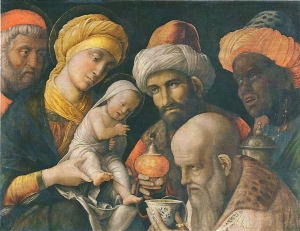The Pumilio Child by Judy McInerney
I did not know when standing in front of a Mantegna painting, always a slightly off-balancing experience, what an extraordinary story might lie behind it? My ignorance covered merely the basics: painter lived in Renaissance Italy, worked mostly in Venice and Mantua, only about 50 paintings still extant, many of them murals.
 I have never been to Mantua, but have seen some canvases around the place – the last one being The Adoration of the Magi which was loaned to the British Museum for their great China Exhibition, because someone spotted that one of the Magi, an oriental, is offering the Christ Child frankincense or myrrh in a blue and white Ming bowl – the near replica of which was on show in the exhibition. [Minging at the British Museum posted 27th October 2014].
I have never been to Mantua, but have seen some canvases around the place – the last one being The Adoration of the Magi which was loaned to the British Museum for their great China Exhibition, because someone spotted that one of the Magi, an oriental, is offering the Christ Child frankincense or myrrh in a blue and white Ming bowl – the near replica of which was on show in the exhibition. [Minging at the British Museum posted 27th October 2014].
Who knew that there was an even darker trade that went on between Italy and China at around that time? Who knew at all that Ming Dynasty China (1368-1644) had a flourishing outgoing slave trade?
In The Pumilio Child, Judy McInerney imagines that Andrea Mantegna (1431-1506) saw a beautiful Chinese slavewoman in the slave market in Venice, and although his finances were precarious, he scraped together enough to buy her, in order to add her exotic beauty to one of the frescos he was currently painting for the ruling Gonzaga family. But the story does not end there…
So, if you want to read this novel, and I certainly do, go to Unbound and make it happen. This is the crowd-funding engine for unpublished books.
https://unbound.co.uk/books/the-pumilio-child
The Synopsis
The Pumilio Child is a dark, unsettling thriller that challenges the perception that Italy during the Renaissance was cultured and refined. The day-to-day reality was surprisingly barbaric.
The characters in Andrea Mantegna’s dazzling family fresco in the Gonzaga Palace in Mantua come to life to reveal the story of the survival of a young slavewoman.
Ya Ling’s cultured life of privilege in Beijing is cruelly cut short when she is abducted and shipped to the slave market in Venice. When celebrated Renaissance artist Andrea Mantegna sees her chained to a post, although his finances are perilous, he digs deep and buys her. His initial intention is to paint her exotic beauty, but he soon moves her into the harness room for pleasures of a more private nature.
Ya Ling has two ambitions, to ruin Mantegna, then to escape her brutal and sordid life in Mantua and return back to her family in China. However, Mantegna’s latest commission, two huge frescos for the ruling Gonzaga family, make him invincible.
This gripping story introduces a bizarre and vicious practice that took place during Renaissance times. It was so corrupt and disturbing it has been wiped from history.
Until now.



